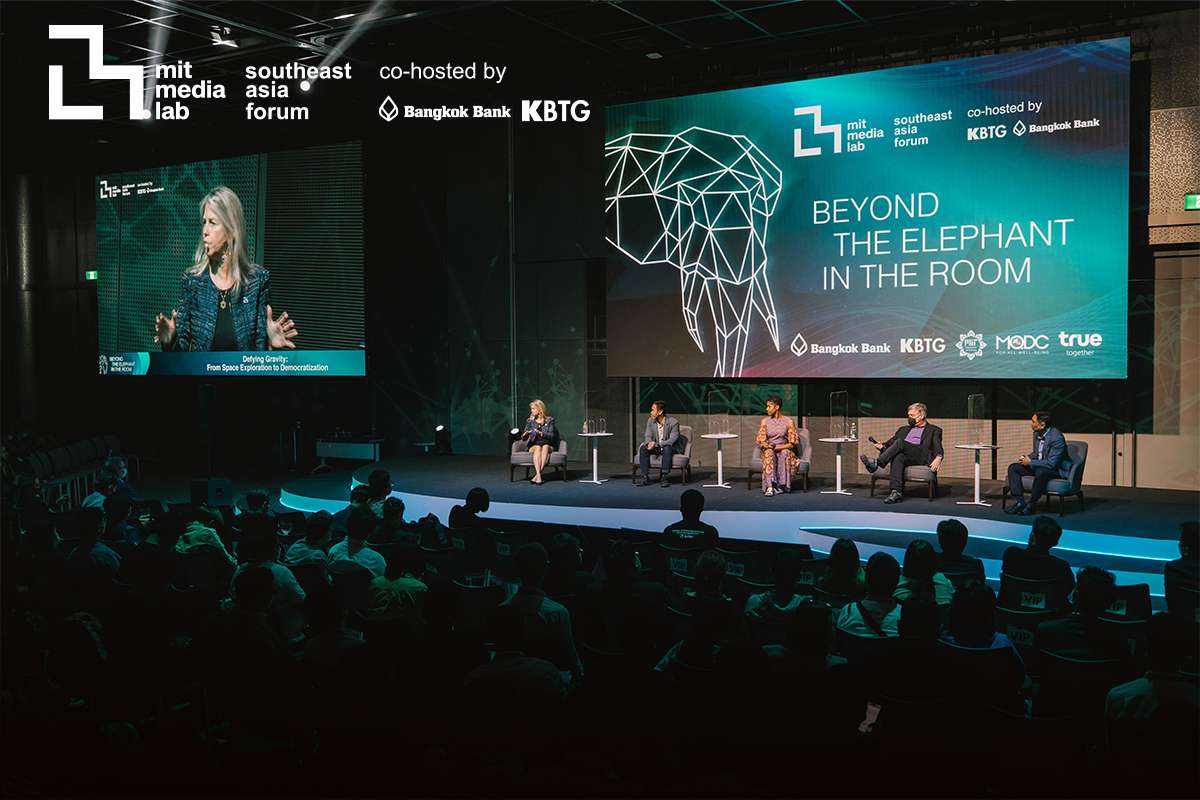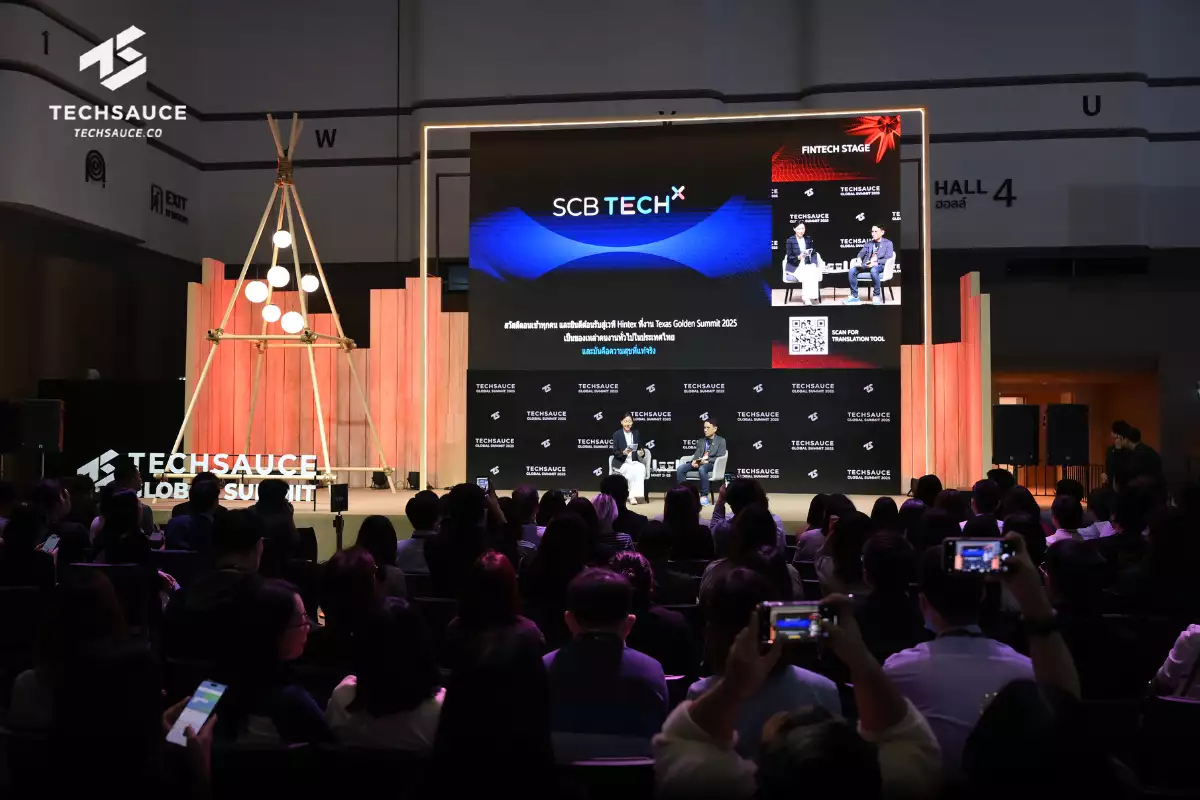Unlocking the Future: What we gathered from MIT Media Lab Southeast Asia Forum 2022
Last year couldn’t have ended better than with the MIT Media Lab Southeast Asia Forum 2022 under the theme “Beyond the Elephant in the Room” which was co-hosted by the MIT Media Lab, KBTG, and Bangkok Bank with the support from True Group, MQDC, MIT Alumni Association in Thailand and other Thai corporations on 19-21 December 2022.

What is “The Elephant”?
Simply speaking, “The Elephant” refers to humanity’s greatest challenges that are often ignored. The forum greatly summed up the latest technological innovation and ideas that can eventually be transformed to better our future.
Key speakers from the MIT Media Lab pointed out to the audience what great possibilities there are in the technological world today. Whether it is in medicine, the environment, school, or even in our very own living space, everything around us can be amplified for greater use with the help of technology.
Here is what we have summed up from the event:
Day 1: Unlocking Possibilities
Day one was mainly about new technologies being explored and that for humanity can utilize and use them for a better future. Let’s look more closely, shall we?
X-Verse: Being Digital + Digital Beings
This session mainly focused on how digital instruments can enhance our living and better our understanding of today’s world. Interesting key points are the use of Future You (an interactive chat platform that allows users to chat with a relatable yet virtual version of their future selves in real-time), TeleAbsence (being remembered and connected after death) and sensor portals in various places and surroundings.
X-Verse is not a place, but it’s an experience.
said Pat Pataranutaporn, PhD Candidate, MIT Media Lab Researcher and KBTG Fellow. Pat made several interesting key points addressing how AI can enhance our learning experience, connect us with our past and future, and eventually augment humans with virtual humans.
Creativity Across Scales: Co-Creating Communities of Possibilities
Relating to the previous session, this session highlights the products of creativity and how we can use it to change our way of living within the community. With key concepts of synthetic biology, Scratch, Octoplay and generative AI, this session literally sparked creative ideas and innovative thoughts among the audience.
Take the younger generation as an example, what can we do to initiate their creative sides of learning? They are the seeds or future plants, after all. Professor Mitchel Resnick is known to help the younger generation connect with one another through an application like Scratch and Octoplay. Both are immensely innovative, enabling the children to think, create and share their imaginations with one another through their virtual art pieces. He believes in connection across the world, not just with educators, but with parents and policymakers as well.
Cyborg Health: From Dream Engineering to Nano-Robotics
Similarly to being digital and creative, Cyborg Health underlines the use of technology in today’s medical world. Ranging from the implementation of Fascia products that enhance better sleeping to nano-electric devices aiding in early diagnosis and preventative measures in healthcare, it truly changes the outlook on medical advancement today.
With growing concerns in both physical and mental healthcare , AI has played an important role in achieving these goals. The goals range from early diagnosis, preventative measures in neurodegenerative diseases, and simple tasks like improving our sleeping patterns to finding medicines for astronauts.
Professor Deblina Sarkar, who leads the Media Lab’s Nano-Cybernetic Biotrek group, aimed to create a new paradigm for life-machine symbiosis to transform healthcare. Some of her works focused on helping patients with neurodegenerative diseases like Parkinson's and Alzheimer's through the use of Spatio-Temporally Precise Brain Stimulation. Although the device cannot heal the patients 100%, it can ameliorate the symptoms to milder conditions. Eventually, on a positive note, Sarkar’s invention could be applied to all different age groups, even infants.
Defying Gravity: From Space Exploration to Democratization
Navigating through outer space, the session is directed at space exploration and how it affects our loving Earth. The main prospects are BioSuit, Space Haptic technology, and how we can make exploration of space more accessible and sustainable.
The thought of going to outer space may seem too far-fetched for many people. Our key speakers made it look so familiar and achievable. We may often wonder what is out there and what we can do or learn from this cutting-edge space technology.
Professor Danielle Wood said
Space is for all of us. Let’s increase accessibility and make sure everything is safe for the next generation.
With that thought in mind, the invention of BioSuit (Professor Dava Newman) and Electronic Textile Conformable Suit (Irmandy Wicaksono) all took part in making exploring outer space possible, as well as the ability to live on planets such as the moon and Mars. However, Professor Dava Newman thought that instead of a total focus on living in outer space, humans should pay more attention to life on Earth. After all, the condition on Mars is still very harsh, with extreme cold and inhabitability.
Day 2: Endless Possibilities
Moving on from day one, day two was all about the possibilities in the tech world that could change and eventually enhance humans’ well-being. We started off with a dance performance of ‘Tapis Magique’ invented by Irmandy Wicaksono. Irmandy’s idea of the carpet was to combine the sensory function of the carpet’s textile and the movement and posture of the dancer. The concept was for the two to harmoniously enhance each other’s qualities.
After the performance, a governor of Bangkok, Dr. Chadchart Sittipunt, gave an inspiring introduction speech to the audience. He mentioned that by focusing solely on the technology rather than on the people, the city could not be properly developed.
You need to create trust among people to improve the development of the city.
He then left us on a note encouraging us to think more ‘people-centric’ before going ‘city-centric’.
Such an introduction from the dance performance and the governor himself left us wondering, ‘what could be brought more to the discussion today?’ We started off quite interesting already. Let’s see what happened on day two.
E-Topia: Sustaining Cities with Smart Technologies
Does this topic remind you of all the ‘smart’ things you see around your city? Whether it is smart cars, smart cities, smart buildings, or even smart homes. Everything around us today is and seems smart. The reasons behind it are unraveled in this session.
Luis Alonso ignited the idea of how we can decrease the amount of CO2 per person by designing our community through the use of smart technologies to living space. The idea of having a compact and highly optimized is not only new but also very functional. To decrease Carbon Dioxide, one needs to spend as little energy as possible. Activities such as commuting to work or eating out should be carefully designed into the city’s landscape and development plan.
The use of smart technologies is not only found in urban planning but also in environmental activities. As Professor Danielle Wood highlighted how we could use satellites to track gold mining activities in order to alleviate the problem of deforestation, we can be assured that smart techs can enhance all well-being in the world.
As environments are becoming more harmed and global temperature is on the rise, Professor Dava Newman, who initiated the ‘Climate Pocket,’ an application that can track disasters beforehand, encouraged us to believe in human potential that no matter how alarming the situation is, we can change it.
Interest of Values: Digital Currency, Web3, and Trustworthy Network
What age are we living in right now? The internet/digital age, of course. This session moves us forward with the ideas of how we can work together with AI in order to optimize the decentralized network that is in the making as we speak.
Using AI to make decentralized networks happen is a long and complicated process. Guy Zyskind suggested that for the idea to work, it needs to cover the problems that MIT had been working on for over a decade; scalability, privacy, and user experience. ‘Prompting Accuracy,’ the idea proposed by Ziv Epstein, was a decentralized way of preventing misinformation spread on the internet right now. Therefore, in order for the decentralized network to succeed, the development of Web3 and Prompting Accuracy would need to go hand in hand, as one cannot stand without the other.
With a goal of enlarging the scale of web3/decentralized network, billions of dollars are spent on research to ensure it's happening. Though it may take a long time, the results promising. That is, it allows users to be able to track the operation, data, and even transactional proof. The key idea is to work together, and together means humans and AI.
As Luis Alonso said,
Without humans working together, AI and other technologies cannot come true.
Extended Mind: From Artificial Intelligence to Intelligence Amplification
The most asked question today would be, ‘Have you ever wondered if humans will ever be replaced by AI?’ Well, Professor Pattie Maes has an answer to that question.
With a growing capacity and demand for AI, most of us fear that human workers will be replaced by AI. Professor Maes assured us not to worry because instead of being replaced, humans will eventually be enhanced and augmented by AI. Therefore, we need to work collaboratively with AI and trust the system in order for it to succeed.
Think about this, humans are reportedly to believe medical advice from AI rather than from their own doctors. This does not mean that doctors will be replaced by AI. It means that it is about time that doctors or any other professions improved their capabilities. We all can eventually live with one another, and by that, I mean also with Artificial Intelligence.
Furthermore, Guy Zyskind added that
With decentralized collaborative AI, we get a better system that would help us train the next generation of AI models that will expand and augment our intelligence.
Material Alchemist: Bits, Atoms, Magic
The key idea we have presented so far is how we can work more efficiently with AI and how AI can enhance our capacity. Let’s see more tangible examples of human innovations that, a lot of times, can only be described as magical.
This session mostly presents the scientific work of art from our key speakers. The main theme is how we can incorporate the main features of certain materials such as textiles, radical atoms, or BioCement into a workpiece that can cherish the relationship humans have with nature. These materials come from nature, after all. What could be better than engaging them in our everyday life?
Professor Hiroshi Ishii presented his masterpieces which derived from the use of materials like frozen atoms, tangible pixels, and radical atoms. Some of his works were I/O Brush (when your environment becomes your palette to draw with) and PingPongPlus (a digital augmentation of Ping Pong using a reactive table). His main features of using materials to utilize and optimize his products really coincide with Irmandy’s work.
Like Professor Hiroshii, Irmandy’s ‘Magic Carpet’ or ‘Tapis Magique’ explained how we could use spatiotemporal pressure-imaging sensory data in the carpet to enhance the movements and postures of a dancer. All of which we can be assured that it is possible to create a workpiece derived from material found in nature.
Dr. David Kong summed up the session by not only presenting the work of using bacteria to make cement, but also emphasizing the significance of our relationship with nature. As we are moving forward to a more advanced technological world, we tend to lose sense of nature along the way.
He then left us with the question, ‘What kind of ancestors will we become?’ He furthermore encouraged us to move forward with technology together with the relationship we have with each other and the natural world. We should, inherently, think of ways we can use technology to improve our lives.
ลงทะเบียนเข้าสู่ระบบ เพื่ออ่านบทความฟรีไม่จำกัด






